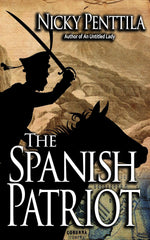caption: United Empire Loyalist monument, unveiled on Empire Day, 23 May 1929, at Prince’s Square on Main Street East in Hamilton, Ontario. Source Saforrest (see words from memorial below)
One of the strong influences on my novel The Spanish Patriot was learning about the American colonists who did not wish to separate from Britain during the revolution and civil war of the late 1700s. From what I’d learned in school, I assumed there were maybe a few grump-headed Loyalists, some of whom joined the British to fight against the rebels (Benedict Arnold!), but then after peace was declared everyone quickly fell back into happy coexistence.
Not so.
Not a sliver, but some 15-20 percent of all the white people in the colonies were Loyalists, also called Tories or Royalists. In fact, according to Robert M. Calhoon in A Companion to the American Revolution:
Not all loyalists were white Europeans, either. Thousands of enslaved people escaped to British lines, especially after Lord Dunmore’s “Emancipation Proclamation” in November 1775. Dunmore, fighting to hold the power of his position as royal governor of Virginia and bolster his 300-man army, declared all revolutionaries traitors to the Crown and promised freedom for slaves of American revolutionaries who left their owners and joined the royal forces. From 800 to 2,000 slaves of all ages and genders are thought to have joined with Dunmore. Some 300 men were enlisted into what was called Dunmore’s Ethiopian Regiment; others served in guerrilla units and other services. Later some would form the Black Pioneers mulitary unit, including Henry Washington, who had fled the plantation run by George and Martha Washington.
In 1779, British General Sir Henry Clinton issued the Philipsburg Proclamation, which freed enslaved people owned by revolutionaries throughout the rebel states, even if they did not enlist in the British Army. Perhaps as many as 100,000 people in total escaped from rebel areas during the years of civil war. (Native American groups, at first mainly neutral in the conflict, also eventually chose one side or the other, with painful repercussions.)
For my fictional Wakefield family, the choice of which side to take was tough. As printers who held the contract with the Virginia government, they would have made their living producing proclamations, forms, and other official documents, though they also took jobwork like blank forms, books and almanacs, theater announcements, and, of course, their Gazette, a weekly newspaper. Their newspaper, like most others, printed mostly international and national news; not much local news except advertisements and official announcements. Challenging royal authority could lose them their printer’s license.
But people with printing presses could be great mouthpieces for calls for change and revolution; already shops in more northern colonies were writing what could be called sedition.Jordan and Mary Wakefield in Williamsburg felt great pressure to call for revolution, but to do so meant their business would fail. It was not clear if the revolutionaries would pay for the jobwork they wanted. However strongly you felt you wanted to stay neutral and work through peaceful means, it was growing clear, though, that if you were not with them you were against them.
As Catholics, who already had left England because of persecution, the family also did not find these patriots any more accepting of freedom for their religion.slave
The Wakefields decided to flee, dismantling their press and moving it first to Charleston, until Charleston fell, and then to formerly Spanish East Florida. The war ended in British defeat, but for this family and many others the displacements and upheavals continued.

The plaque reads:
This monument is dedicated to the lasting memory of
THE UNITED EMPIRE LOYALISTS
who, after the Declaration of Independence, came into British North America from the seceded American colonies and who, with faith and fortitude, and under great pioneering difficulties, largely laid the foundations of this Canadian nation as an integral part of the British Empire.
Neither confiscation of their property, the pitiless persecution of their kinsmen in revolt, nor the galling chains of inprisonment could break their spirits, or divorce them from a loyalty almost without parallel.
No country ever had such founders —
No country in the world —
No, not since the days of Abraham. – Lady Tennyson
**See also next post: Loyalists: American refugees
More info:
Nonfiction
Liberty’s Exiles: American Loyalists in the Revolutionary World, Maya Jasanoff (2011) – my top resource for this part of the story
Dunmore’s New World, James Corbett David (2013) – I heard him give a talk during VA Festival of the Book just as I was finishing my story
Wikipedia entries: Loyalist (American Revolution), Black Loyalist, United Empire Loyalist
Fiction
The Traitor’s Wife (2014), Allison Pataki
The Loyalist’s Wife (2013) and The Loyalist’s Luck (2014), Elaine Cougler
The Tory Widow (2009), Christine Blevins
The Book of Negroes / Someone Knows My Name (2007), Lawrence Hill
Oliver Wiswell (1999), Kenneth Roberts
The King’s Rangers (1954), John Brick
With Nothing But Our Courage: The Loyalist Diary of Mary MacDonald (2002, young adult novel), Karleen Bradford
Sarah Bishop (1991, young adult novel), Scott O’Dell

